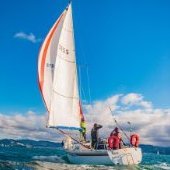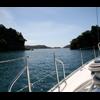
AlastairW
Members-
Content Count
72 -
Joined
-
Last visited
-
Days Won
1
AlastairW last won the day on October 17 2022
AlastairW had the most liked content!
Community Reputation
15 NeutralAbout AlastairW
-
Rank
Member
- Birthday 18/05/1955
Profile Information
-
Gender
Male
-
Location
Dunedin
Recent Profile Visitors
960 profile views
-
Positively tropical in Lords River and Paterson Inlet too
-
Nah, whole point of me using my big steel boat to find as many uncharted rocks as possible was so that you don't need one. Less scratches on the keel than I thought there might have been too !!
-
There is a new, updated cruising guide to Stewart Island / Rakiura now available. A bit more comprehensive than the older guide, 85 pages, chartlets and satellite illustrations, and, best of all, free download as a pdf. Download is hosted by the Otago Yacht Club on their web site at https://otagoyachtclub.org.nz/wp/stewart-island-sailors-guide/ Feel free to share it around
-
No problem, matter closed. As I said, we can just agree to disagree.
-
With all due respect, I'd suggest reading Eric's articles that were referred to earlier. The rationale behind utrasound as used on small boats isn't to try to kill existing organisms with high power sound (which you can do - I know a fair bit about that), instead, the aim is to stop the establishment of organisms on the hull while they are still at the immature stage. That can be done quite successfully using a low powered unit. Different organisms are susceptible to different frequencies, so you need to deliver a swept frequency pulse. You also need to have an adequate number of transducers,
-
I can second that
-
The product isn't keeping us clear of barnacles, we'll have to agree to disagree about the ultrasound. I KNOW that the unit we use, with correctly positioned transducers, is very effective on our steel yacht. It would be a bit less so on a GRP yacht, and totally ineffective on a wooden or ferro one. I'm no expert, but do have a background in relevant underwater acoustics research, I understand the underlying theory, and also the constraints on the practical application. Anyway, as I said, I'm happy to agree to disagree, I'm not pushing a product, each to use the tools they find works for them.
-
Can't say what other hard products would be like, but the stuff we use is HARD. Very resistant to abrasion. We haul on a cradle, but I don't see how soft strops will cause damage. We still use Propspeed, though I am considering trying some Seaspeed on it this year. It may or may not take to the prop, I don't know, my feeling is that it won't last for any longer that Propspeed, but I have some on hand, so nothing lost by trying. I gave up racing 30 years ago so wouldn't even try to interpret the rules, but, the co-efficient of friction of a non stick silicone is surely less than conve
-
You'll notice I said ABOUT a knot......... If you have your doubts, that's fine.
-
Most of that is pretty accurate Wheels, we're looking to get somewhere around 10 years out of the product we use, at least that's what the US manufacturer quotes in their literature, and I expect they would get their backsides sued off over there if it wasn't the case, and they've been in business with this product for some time. Minimum speeds are now lower too, thankfully. There's not a hope that we could ever get our boat up to 12 knots. Some products will now start stripping at about 6 knots. When we were looking at what to use to replace the original soft coating, I came across one produc
-
Dave, the stuff we have (Seaspeed V10x) self cleans reasonably well as long as you are using the boat a lot, and don't give the slime a chance to get a hold. But once any fouling gets a hold, it gets more difficult. With the slime, we find that if we get out in a decent wind and a bit of a seaway, when we come back in again, we can see where it has started to wash off. We have dirty slime down here....... Leave the boat sitting on the berth for longer than a few weeks though, and it gets harder. Washes off really easily though when I get physical with it. I took the boat out of the water
-
Antifoul has nasties in it that deters or kills the offending biology, silicone foul release doesn't. It operates like a non-stick frying pan, so the greeblies are washed off by the motion of the boat through the water.
-
I've been using silicone foul release for over 5 years now, started with soft coating since it was all that was available, now using a hard coating. The soft coating was a nightmare to apply, and failed to live up to the durability claims. We were told we would get 5 years out of it minimum. It did it's job as a foul release, but wore so rapidly that we had to start considering replacing it after just over 2 years. Thankfully, that product is no longer available. We've been using a hard coating now for about 2.5 years. It performs better all round. When clean, at cruising speed under
-
5kg bottle - 4 weeks give or take a wee bit. 2 people, hearty meals cooked from scratch, using the oven for baking etc about every other day, sparing use of the Califont. Use a wee bit less when it's warm, a wee bit more when the temperature drops.
-
1 Dunedin to Havelock and back over the December to February period, immediately followed by a run down to Stewart Island which was cut short by lockdown. Pity it had to come to a halt. 2 Back down to Stewart Island in one of the good weather Winter spells (we have a good cabin heater.....)






